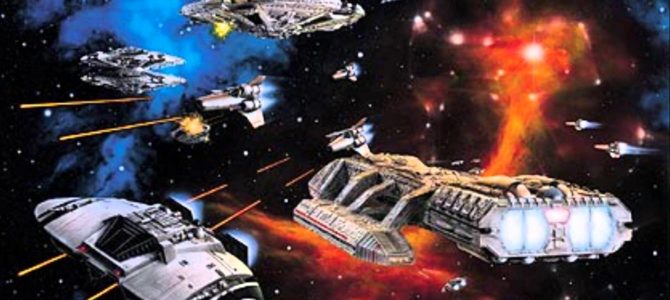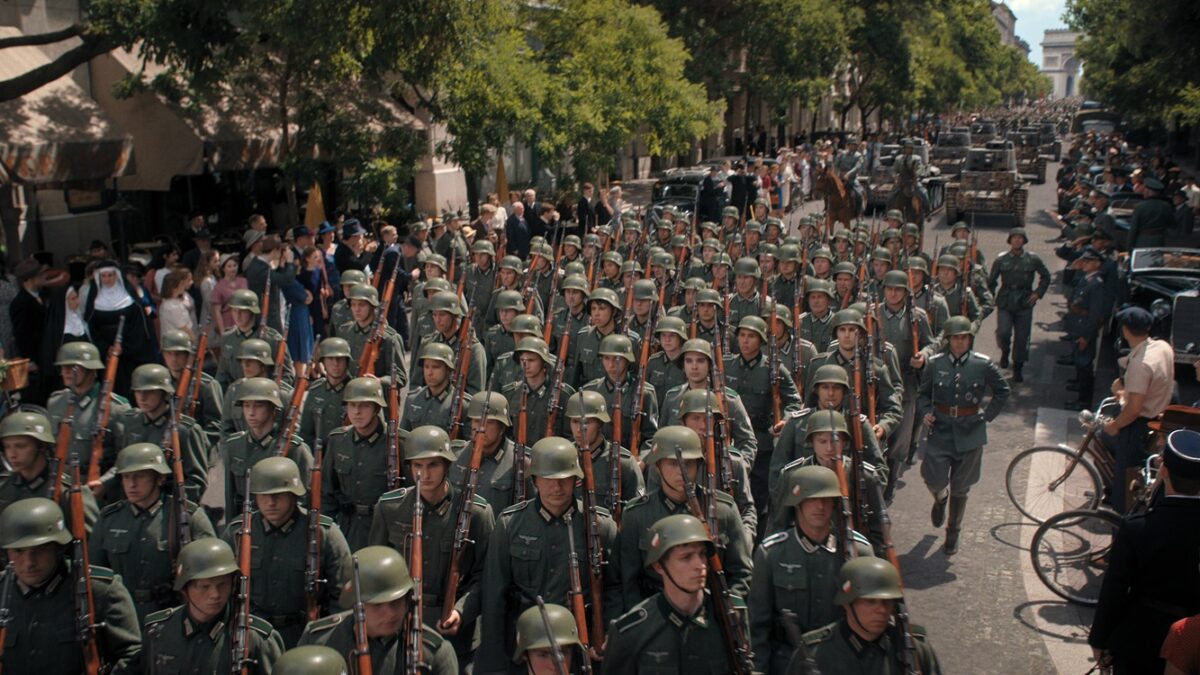
This is the second in a series of “Battlestar Galactica” recaps. This year marks the 15th anniversary of the franchise. Read the last piece, “Revising Battlestar Galactica: The Mini-Series,” here.
Spoilers ahead.
“33” is often cited as a standout “Battlestar Galactica” episode because its plot is a microcosm of the TV series. Yet “33” also excels at the small things in moving from mini-series to weekly drama.
As we rejoin the action, a relentless Cylon pursuit is forcing the rag-tag fleet to make faster-than-light (FTL) escape jumps every 33 minutes. Digital countdown screens and analog clocks with the 33rd minute marked by tape convey a pressure-cooker atmosphere.
Galactica’s Viper fighters engage the Cylons long enough for Pres. Roslin’s ship – Colonial One – to repair its FTL drive for jump 237. The crew has not slept for over five days, as reflected in their mood. On the flight deck, Crewman Specialist Cally Henderson (Nicki Clyne) asks (mostly to herself), “Why do the Cylons come every 33 minutes? Why isn’t it 34, 35 …” Deck chief Tyrol tells her to shut up (the show never answers her question).
Once jump 237 is completed and the clock is reset, the crew attempts other business. Adm. Adama and Col. Tigh repair to Adama’s quarters to formulate a strategy — one which may not be feasible, given the constant demands of their plight. At least Adama shaves while Tigh snacks on the admiral’s noodles.
Petty Officer 2nd Anastasia Dualla (Kandyse McClure) leaves the Combat Information Center (CIC) in an unsuccessful attempt to have a picture of her family transmitted throughout the fleet. While returning to the CIC, she walks down a long corridor with a photographic shrine to those already missing or lost.
Dualla briefs Adama and Tigh on the mounting cases of exhaustion. Adama orders that stimulants (“stims”) be dispensed to essential personnel, including Viper pilots. The order does not sit well with Starbuck, who believes stims impair her performance.
As tempers fray, Starbuck angrily challenges Apollo, the new Commander of Air Group. She critiques his downbeat briefing in prep for jump 238 and his reluctance to order her to take the stims she does not want. A tense pause following Starbuck’s eruption dissolves into the sleep-deprived laughter of the two pilots, after which she takes her pills.
On Colonial One, Roslin and her aide Billy Keikeya (Paul Campbell) learn that counting errors and recent losses have reduced the number of surviviors by 300. They also receive a message from a civilian ship named the Olympic Carrier that a Dr. Amarak wants to meet with Roslin, though there is no time for it before jump 238.
The request startles Baltar, who has been coping with the pressure by escaping into the memory of his old lake house, where he has been debating religion with Six, his Cylon lover. Baltar fears that Amarak, a former Defense Ministry colleague, may implicate him in the Cylon attack on the colonies.
Following jump 238, Dualla reports the Olympic Carrier and its 1,345 humans as missing. Tigh blames Dualla, who failed to log the ship’s status before the jump; Adama is also tough on her. Baltar is relieved that Amarak seems to have vanished.
However, the 33-minute countdown expires after jump 238 without the Cylons appearing. Roslin wonders whether this is related to the missing carrier. Adama is unsure, but reduces Galactica’s alert status and dispatches Apollo, Starbuck and Boomer to patrol the area.
The Olympic Carrier then reappears at some distance to the fleet. The carrier captain informs the patrol that the ship’s FTL drive had broken, but the Cylons failed to attack before they escaped. The captain also relays that Amarak would like to inform Roslin about a traitor.
Adama resets Galactica to full alert and the clock to 33 minutes. In Baltar’s mind, Six claims the situation is God’s punishment for Baltar’s secularism and resistance to the idea of fathering a child with her. At Six’s suggestion, Baltar advises Roslin the Olympic Carrier is a threat and must be destroyed.
Roslin and Adama cut communications with the Olympic Carrier, which ignores warnings from the patrol as it approaches the fleet. As Cylon forces appear, nuclear weapons are detected on the carrier.
Roslin and Adama order the destruction of the Olympic Carrier (a moment after Baltar mentally repents his sins at Six’s urging). Starbuck initially questions the order, but obeys when Apollo begins firing on the carrier, with all unsure whether the passengers were alive. Apollo apparently had more grit than big-talking Starbuck believed.
The fleet escapes without further Cylon pursuit. Roslin, Adama and Apollo all feel the weight of their roles in destroying the carrier. But Roslin enjoys a moment of happiness upon learning a baby was born recently.
“33” also includes a “B” story involving Helo’s attempt to survive on Cylon-occupied Caprica after allowing Baltar to leave in his place during the mini-series. He is briefly captured by a Six and a Cylon Centurion, but escapes with help from a copy of Boomer who is posing as Helo’s former co-pilot.
The main plot of “33” not only encapsulates the existential thrust of the series, but also addresses more post-9/11 anxieties. In addition to the photo shrine, the fear of having to shoot down civilian aircraft lingered for years after 9/11. Some may forget that Vice Pres. Cheney ordered the downing of United 93 before passengers wrested control of the airplane from al-Qaeda terrorists.
The “B” story — and Baltar’s mental escapes to his lake house — cleverly serve as a relief to the viewer, a subtle message that you will not be as trapped onboard Galactica as its crew.
Cinematography is also a key to “33.” The mini-series was shot on 35mm film, but the series was shot on what was then the new format of high-definition video.
Hi-def brings out the aging of the equipment in the CIC, while the flight deck’s contrasty glare contributes to the harsh atmosphere of “33.” Hi-def also can be unflattering to actors; the show takes advantage of that problem, emphasizing the weariness of the crew (much to the chagrin of Sci-Fi Channel execs premiering a series with the stars looking awful).
Lastly, “33” relies even more on the mockumentary style used in the mini-series. The hand-held camera not only lends an appearance of realism to an unreal setting, but also subtly affects the show’s pacing. “33” is unrelenting, but the photographic style captures small moments at the outset or ending of a scene, such as Dualla’s long walk past the photo shrine, or Tyrol’s bemused reaction to Starbuck and Apollo’s dispute over his leadership style. This attention to detail and character will matter to the series as much as the suspense and action.









